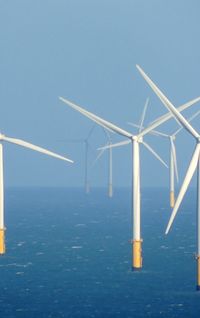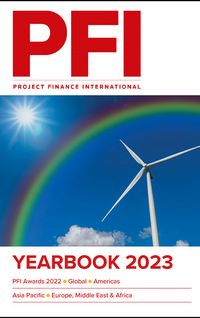Hydrogen, one of the most abundant elements on Earth, can be produced from a diverse range of resources, including non-renewable resources such as fossil fuels, and cleaner, more sustainable resources such as wind, solar, geothermal or biomass. By Tom Fotheringham, partner, and Lisa Huynh, solicitor, both at DLA Piper.
Due to advancements in renewable technology, hydrogen has been hailed as a solution for cutting the carbon footprint of industries that are notoriously hard to decarbonise.1 As a result of its versatility, hydrogen has the potential to serve as a coal replacement in steel production, as feedstock for ammonia production, and as a reticulated natural gas replacement for residential and commercial heating, and can be used to reduce the harmful effects of petroleum refining and as an alternative source of supply to electricity markets.2
Investment in "green" hydrogen production is a key economic and reputational opportunity identified by stakeholder countries such as Japan, South Korea, China and Singapore, all of which have ambitious targets to progress decarbonisation activity and reduce overall greenhouse gas emissions to net-zero.3 While perhaps best known as one of the largest exporters of liquefied natural gas, Australia has a multi-disciplinary and rapidly diversifying energy industry that draws expertise from various sectors. Coupled with a growing momentum of more than 100 hydrogen projects worth A$163bn currently under development in Australia4 and the Commonwealth Government’s commitment to invest A$1.2bn towards building a local hydrogen industry5, Australia is well placed to capitalise on this golden opportunity.
The financial services sector will undoubtedly play a key role in driving the success of the green hydrogen revolution to replace fossil fuels, which will require external bank debt to finance early pilot and large-scale hydrogen projects. Despite the significant number of hydrogen projects being developed in Australia, relatively few project financing deals have been closed, as banks are reluctant to shift from investment in conventional wind and solar projects to novel technologies such as green hydrogen. This reluctance stems from the challenges associated with commercialising green hydrogen, particularly around interface and technological risks, regulatory constraints, costs associated with safe storage, transportation, and the need for bankable offtake schemes – all of which are fundamental to a successful hydrogen project.
In this article, we explore some of the key challenges that financiers and project sponsors will need to consider in overcoming these bankability issues as Australia transitions to net-zero by 2050.
Offtake arrangements
In order to secure finance, a hydrogen project must have a bankable offtake scheme. As the merchant market for hydrogen hasn’t matured like the wind and solar industry and there is limited offtaker interest in Australia6, there is a heightened risk among financiers as to whether a project company can earn sufficient revenues to both service its operating costs and debt and produce an adequate return. Consequently, hydrogen projects will experience an initially slow uptake in receiving project finance and may need to rely on government grant funding or private investor funding to raise capital as operations expand from pilot to commercial scale.
As the market for hydrogen matures, technology is refined and large-scale infrastructure is developed, robust pricing mechanisms are likely to emerge. In such circumstances, hydrogen is poised to become an increasingly attractive green alternative, particularly to market entrant offtakers such as mining, transport and steel operators seeking to decarbonise.
Hydrogen pricing mechanisms may include traditional, fixed-price models or bespoke, variable formula.
* Fixed price – A likely candidate pricing mechanism in the nascent hydrogen market is the traditional fixed-price model whereby a unit of hydrogen is sold at a fixed price per unit (in kilograms). A PwC Australia report titled “Getting H2 right: Success factors for Australia’s hydrogen export industry” forecasts that the cost of green hydrogen production will experience a linear decline from A$5.70–A$6.10 in 2025 to A$1.65–A$2.05 in 2050.7 PwC suggests that the primary drivers of this decline will be a reduction in the cost of large-scale electrolysers, increased availability of sustainable, low-cost renewable electricity in Australia available for the production of hydrogen, and growth in domestic manufacturing capability to avoid supply chain issues.8
Forecasts such as these indicate that until the technology advances, agreeing to a fixed price before a final investment decision will mean that the project sponsor will be liable for any cost overruns, particularly if the input price increases at the infancy stages of the project – a risk that the financiers may not consider palatable from a project financing perspective. However, if the analysts’ forecast of the cost of green hydrogen production does indeed hold water, then the project sponsor will make a profit in the later stages of the project life-cycle based on the profit margin given that the fixed price is greater than the market price.
* Variable price – An alternative to the traditional fixed-price model is a pricing formula that is designed to include the production cost and capital expenditure incurred to build a hydrogen facility, having regard to variable and fixed costs9, plus a fixed price of hydrogen. Variable costs may include the production costs required to produce green hydrogen, such as the costs of renewable power, electrolyser costs and intermittency of power supply.10 Fixed costs include costs incurred to maintain the facility, such as the supply of spare parts, rental fees for the lease on site where the project is located (if applicable) and a profit element for the sale of hydrogen per unit. This type of pricing mechanism would be more favourable to financiers as the risk associated with the fluctuation of input costs would to some extent be borne by the offtaker rather than the project sponsor, thereby providing a secure revenue stream for the project sponsor.
In order to mitigate any revenue risk, a project will need clear end-use markets and a credible offtaker in order to give financiers this assurance. Although conventional balance sheet-based corporate credit analysis is the first step in determining an offtaker's credit risk and whether an offtaker can pay for the product, the financiers may consider taking security over the project sponsor’s own revenue and undertake its own due diligence enquiries as to the offtaker's creditworthiness.
Technology risk
As with all emerging technologies, there are several risks associated with green hydrogen that hinder the bankability of various initiatives in the space. Technological risks include potential delays that may arise in the development of new infrastructure, the unproven scaling of electrolyser technologies required for projects with larger outputs and the durability of electrolysis cells and their components.11 As a result, financiers are currently reluctant to provide project financing for these hydrogen projects due to this new and untried technology, the performance of which cannot be measured against existing benchmarks. In these circumstances, financiers may seek to mitigate risk by:
* Focusing on the performance of electrolysers with a heavy reliance on technical due diligence reports and ensuring that the project sponsor can stress-test key technical assumptions such as efficiency, losses and degradation12;
* Requiring the engineering, procurement and construction (EPC) contractor to give a long-term performance guarantee rather than the general warranties provided13;
* Ensuring, to the financier’s satisfaction, that the EPC guarantees and equipment warranties being provided by the EPC contractor and the original equipment manufacturers can be relied upon if there are any defects identified in the facility14; or
* In the case of project sponsors, providing a long-term performance guarantee that may be counter-guaranteed by the EPC contractor or the manufacturer of the facility.15
Another risk mitigation strategy from the project sponsor’s perspective is to potentially supply renewable energy instead of renewable hydrogen to the grid albeit at a lower price if the electrolyser is experiencing technological issues. This will be feasible if the project sponsor has ownership of the renewable power generator and provides some form of comfort to the financiers that the project sponsor is still receiving a revenue stream from the project to contribute towards the repayment of its debt.
Despite these risk mitigation strategies, there is still reluctance by financiers to provide project finance for hydrogen projects, indicating that the hydrogen market hasn’t matured in Australia yet. However, as large-scale electrolysers become more economical to operate, renewable electricity becomes more affordable, and supply chain issues are alleviated, project sponsors are more likely see financiers willing to provide funding to hydrogen projects in Australia.
Insurance
Due to the complexity and risks associated with production, on-site storage, safety and transportation of gas, coupled with its use in new and emerging technologies16, insurance policies for green hydrogen projects were, until recently, non-existent.
In recognising this gap in the market, Marsh, in collaboration with insurers Liberty Specialty Markets and AIG, announced on August 23 2022 the launch of the world’s first insurance facility dedicated to new and existing green and blue hydrogen energy projects. The insurance facility provides up to US$300m of cover per risk for the construction and start-up phases of hydrogen projects globally and extends to cargo, business interruption, general third-party liability and contingent delay-in-start up insurance.17
Insurers will also play an instrumental role in assisting project sponsors secure adequate insurance for hydrogen projects as part of the project financing requirements and can expect to see a surge in demand from project sponsors procuring insurance during the construction and operation phases of projects as the hydrogen industry develops.
Financing green H2 in Australia
As at the date of this article, green hydrogen projects rely upon substantial government funding and policy support. As the hydrogen industry develops and technology is refined with the support of government grant funding and private equity investment, it is expected that financiers will become the primary source of project finance.
Currently, several financiers have emerged as key players in the market for green hydrogen as they transition to net-zero. For example, National Australia Bank (NAB) is the largest financier of renewable energy projects in Australia and has committed approximately A$11.5bn in funding for 150 clean energy developments worldwide, accounting for more than 70% of its total lending to the green energy transition.18 NAB is now focusing its investment on hydrogen by providing sustainability-linked loans and green lending that will fund growth initiatives targeted at building green projects.19
Similarly, the Green Investment Group (GIG), Macquarie Group’s green arm in Australia and one of the world's leading green investors and developers, have invested or arranged over £25 billion in green energy projects and developed either directly or through portfolio companies over 30GW of capacity20 across more than 240 projects.21
GIG seeks to expand its investment portfolio to encompass green hydrogen initiatives in Australia by partnering with developers to bring on new generation, backed by green bonds.22 These projects include:
* Asian Renewable Energy Hub Project – NW Interconnected, Intercontinental Energy (a key investment arm of the Singapore Government), CWP Global, Macquarie Capital and GIG are constructing a multi-phase 26GW large-scale hybrid renewable energy facility in Western Australia to export hydrogen and ammonia. If successfully developed, the project has a projected production capacity of 1.6m tonnes of hydrogen or 9m tonnes of ammonia per annum.23
* Port of Newcastle Green Hydrogen Hub – GIG and the Port of Newcastle are undertaking a feasibility study to investigate the technical and commercial viability of renewable hydrogen and ammonia production at the Port of Newcastle, New South Wales. The project is estimated to cost A$3m and has received A$1.5m in grant funding by the Australian Renewable Energy Agency.24
Last, in support of Australia’s role as a regional export hub, the Australia and New Zealand Banking Group (ANZ Bank) has released a "Hydrogen Handbook" that explores the economic benefits of using hydrogen as an alternative fuel source.25 ANZ also signalled its commitment to provide funding of at least A$50bn by 2050 to support customers’ transition to net-zero, which includes renewable energy, green buildings and emerging technologies such as hydrogen.26
Moving forward
The challenges associated with commercialising green hydrogen, particularly in respect to bankable offtake schemes, technological risks, insurance, and costs associated with operating large-scale electrolysers, has evidently created investment uncertainty in the hydrogen industry in Australia. However, as the global demand for hydrogen continues to grow and the technology becomes economical to operate, Australia will be well positioned to capitalise on the opportunities presented by hydrogen and become a major supplier of hydrogen to countries such as Japan, South Korea, China and Singapore.
Footnotes
1 - PwC, Embracing clean hydrogen for Australia: How the journey towards decarbonisation can be fuelled by Hydrogen (Report, 2020) 3.
2 - Jose M Bermudez, Stavroula Evangelopoulou and Francesco Pavan, ‘Hydrogen energy system overview – more efforts needed’. (Web Page, September 2022) https://www.iea.org/reports/hydrogen
3 - Ibid 6.
4 - Clean Energy Council, Clean Energy Australia Report 2022 (Report, 2022) 56.
5 - The Hon Angus Taylor MP, ‘Future hydrogen industry to create jobs, lower emissions and boost regional Australia’ (Media Release, 20 September 2021).
6 - Advisian Pty Ltd, Australian hydrogen market study (Report, 2021) 20–4.
7 - The PwC report projects price points as a range in 2025, 2030, 2040 and 2050. Those estimated price points for the price of hydrogen is A$5.70-A$6.10 (2025), A$4.10-A$4.50 (2030), A$2.00-A$2.45 (2040) and A$1.65-A$2.05 (2050). PwC, Getting H2 right (Report, 2022) 3.
8 - Ibid 4.
9 - S&P Global ‘Hydrogen Price Assessments’ (Web Page, 2020) https://www.spglobal.com/commodityinsights/PlattsContent/_assets/_files/en/our-methodology/methodology-specifications/hydrogen-factsheet.pdf
10- Advisian Pty Ltd. (n 6) 9.
11 - Rilke de Vos and Tasman Graham, ‘Anticipating Australia’s hydrogen future’ (2022) Australian Environment Review 138–9.
12 - PwC (n 7) 10.
13 - ER Yescombe, Principles of Project Finance (Elsevier, 2nd ed, 2014) 231 [9.7.1.].
14 - Ibid.
15 - Ibid.
16 - Niket Nishant and Simon Jessop, ‘Broker Marsh launches world first insurance for hydrogen projects’, (Web Page, 23 August 2022) https://www.reuters.com/business/finance/broker-marsh-launches-world-first-insurance-hydrogen-projects-2022-08-22
17 - Marsh, ‘Marsh launches world’s first insurance facility for green and blue hydrogen project risks’ (Press release, 23 August 2022).
18 - NAB. "NAB delivers new ESG financial innovation" (Web page 27 April 27 2022) https://news.nab.com.au/news/nab-delivers-new-esg-financial-innovation
19 - Matt Cenin, ‘Landmark loan strengthens long-term sustainability for Port of Newcastle’ (Media release, 3 May 2021).
20 - This amount comprises of historic activity where UK Green Investment Bank (GIB) (an independent investment organisation owned by Macquarie Group Ltd) or GIB have committed their own funds or arranged third-party capital and/or financing. Green Investment Group. "How we calculate our numbers (Web Page https://www.greeninvestmentgroup.com/en/how-we-calculate-our-numbers.html
21 - Green Investment Group. Progress Report 2021 Accelerating the Green Transition (Report, October 2021) 6
22 - Perry Williams and Victoria Bake Thomson Reuters. The List –The Power Players (online at February 25 2022) 4
23 - CSIRO "Asian Renewable Energy Hub" (Web Page. May 10 2022) https://research.csiro.au/hyresource/asian-renewable-energy-hub
24 - CSIRO "Port of Newcastle Green Hydrogen Hub" (Web Page. May 10 2022) https:// research.csiro.au/hyresource/port-of-newcastle-green-hydrogen-hub
25 - ANZ. Hydrogen Handbook - AH2 2022/Report, 2022
26 - ANZ. ANZ 2022 Climate-related Financial Disclosures (Reprt, 2022) 47
To see the digital version of this report, please click here
To purchase printed copies or a PDF of this report, please email leonie.welss@lseg.com

















